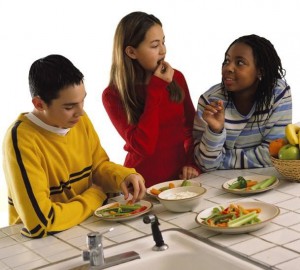
by sbouie | May 19, 2016

Family game night promotes bonding.
Photo credit: commons.wikimedia.org
Warmer weather is here and it is time to plan some fun activities with the family. This is also the time of year when many city organizations have prepared outstanding festivals. Most festivals have something for everyone in the family.
It is always important to socialize as a family. This increases family bonding. Time together, whether outdoors or inside, is vital. There are numerous ways to bond with your family, such as:
- Eating meals together
- Attending children’s extra-curricular activities together
- Reading together
- Going to the library as a family
- Volunteering together
- Family movie night
- Family game night and many more
There are many benefits to planning and having family bonding time. These include:
*Educational Benefits
- Increased focus on homework and reading for pleasure (Eisenberg, Olson, Neumark-Sztainer, Story, & Bearinger, 2004)
- Improved school performance (Hamilton & Wilson, 2009)
- Greater development of language skills (Snow & Beals, 2006)
- Increased and more sophisticated level of vocabulary (Snow & Beals, 2006)
Health Benefits
- Improved development of healthy eating patterns (Hamilton & Wilson, 2009)
- Higher intake of several essential nutrients (Croll, Hannan, Neumark-Sztainer, Perry, & Story, 2003)
- Decreased likelihood of having eating disorders (Ackard & Neumark-Sztainer, 2001)
- Decreased likelihood of being overweight (Fulkerson, Kubik, Story, Lytle, & Arcan, 2009)
- Less likely to develop depressive symptoms (Fulkerson et al., 2009)
Social and Behavioral Benefits
- Less likely to be involved with cigarette, alcohol, and marijuana use (Eisenberg et al.,2004)
- Increased sense of family connectedness, communication, and functioning (Hamilton &Wilson, 2009)
- Increased likelihood of resisting negative peer pressure (Fulkerson et al., 2006)
- More likely to experience positive identity assets (Fulkerson et al., 2006)
- Less likely to attempt suicide (Fulkerson et al., 2006)
- Less likely to engage in sexual intercourse (Fulkerson et al., 2006)
Overall Benefits for the Family
- Regular and consistent family time
- Reduction of anxiety and depression in children
- Increased feelings of togetherness, coherence, and solidarity
- Increased emotional and social bonding
- Shared nutrition
- Relaxing, talking, and laughing as a family unit
Family bonding sets the foundation for a strong family. Family bonding gives your children stories for their present and later years. Enjoy your family time!
*”Benefits of Family Meals”, Varnessa McCray, Victor W. Harris, and Martie Gillen, This document is FCS2324, one of a series of the Department of Family, Youth and Community Sciences, Florida Cooperative Extension Service, Institute of Food and Agricultural Sciences, University of Florida. Original publication date April 2013. Visit the EDIS website at http://edis.ifas.ufl.edu.

by Shelley Swenson | May 19, 2016

You may not need coats and your yard may not have these leaves but finding fun and creative ways to engage children in exercise is important. You can consider yourself successful if they have fun doing so without knowing they are meeting physical activity recommendations by participating in at least 60 minutes of moderate or vigorous physical activity on all or most days of the week.
This is the time to start planning for your children’s summer while they enjoy time at home or at alternative settings from school. Insure they are active to optimize their health.
Being physically active has both mental and physical health benefits. The majority of the benefits becomes apparent in adults because this is the time in which health problems surface. However, risk factors and symptoms for chronic disease may begin as early as childhood, especially in obese children. In addition, physical activity can reduce stress, anxiety, and feelings of depression. Being active improves self-esteem, self-efficacy, and mood and promotes the feeling of overall wellness.
Everybody is short on time, even in the summer. Many people don’t believe they can meet the recommendations for physical activity every day. The good news is that it doesn’t all have to be done at once. Physical activity can be accumulated throughout the day for the same health benefits.
Inactive children are much more likely to be inactive adults. Children who have active family members and who regularly do activities with them are more likely to be active compared to children who do not come from active families.
As you plan your summer, consider how many of these physical activities could become family activities: walking briskly, biking, weight training, yard work, gardening, dancing, golfing, or playing hop-scotch, four square, or active games with running and chasing.
Making physical activity fun with the family can make the time pass by quickly. Finding time to be active together is important for families who want to live a healthy lifestyle.
For more ideas for staying active as a family, check out Raising Healthy Children: Family Fitness and Raising Healthy Children: Active Families.

by Amy Mullins, PhD, RDN | Aug 24, 2015
 Are your kids famished when they get home from school? Kids often hit the kitchen right when they get home and begin the search for something to eat. After being at school all day, it’s inevitable they will bring a host of germs into the house (and into the kitchen). These germs, or microorganisms, can contaminate your kitchen and make your child sick if they are not kept in check.
Are your kids famished when they get home from school? Kids often hit the kitchen right when they get home and begin the search for something to eat. After being at school all day, it’s inevitable they will bring a host of germs into the house (and into the kitchen). These germs, or microorganisms, can contaminate your kitchen and make your child sick if they are not kept in check.
How can kids prepare after-school snacks in the safest way?
Establishing good habits and putting good practices in place can help keep your kids from getting a foodborne illness. The USDA recommends the following:
- Keep all items such as books, backpacks, and sporting equipment on the floor and off of kitchen counters and tables.
- Wash hands first when coming home from school, and again before making and eating a snack. Hands carry lots of germs and can easily contaminate everything they come in contact with.
- Wash fruits and vegetables under running water before eating them.
- Read more about “Food Safety After School”
What are some good after-school snacks?
Choosing easy and healthy snacks for kids can be a real challenge, especially when dealing with picky eaters. Typically, kids feel more independent when they have options and can control what they eat. Parents can set their children up for success by having a variety of healthy snack choices that are easily accessible. Find some great snacking ideas here. Keith Williams, PhD, director of the feeding clinic at the Penn State Hershey Children’s Hospital, recommends having plenty of fruits and vegetables already washed, cut up, and within easy reach of children. Keep the “sometimes” foods out of reach so you can control when your child eats them. “The goal is to make it easier to obtain the healthy snacks you want your child to eat and more difficult to obtain the foods you don’t want him to eat,” says Williams. Read more about “Breaking Your Gradeschooler’s Unhealthy Food Habit” here.
Establishing healthy habits from an early age can transition children into healthier adults. Learn more about making smart choices by visiting http://www.choosemyplate.gov/kids/
by Ginny Hinton | Jul 25, 2015

Young boy drinking a glass of milk
It may be hard to believe, but summer vacation is drawing to a close and school is right around the corner. It’s time to plan for lots of things like new classrooms and teachers, unexpected supply needs, extracurricular activity requests – and hungry kids arriving home from school.
Although it’s easy to succumb to the appeal of ready-made, processed snacks, it can be just as easy and inexpensive to offer healthy but delicious options in single-serve sizes. Following are some quick and simple suggestions:
- Store sliced veggies in the refrigerator and serve with hummus or low-fat ranch dressing.
- Mix dried fruit, unsalted nuts and popcorn in a snack-size bag for a healthful trail mix.
- Wrap sliced, low-sodium deli meats like turkey or ham around an apple wedge.
- Store hard-boiled eggs in the refrigerator for kids to grab any time.
- Purchase fresh, frozen, dried or canned fruits for easy “grab-and-go” options.
- Offer a single serving of individually wrapped string cheese or low-fat yogurt.
- Add club soda to a ½ cup of 100% fruit juice for a tasty alternative to soda.
With just a bit of advanced planning, it’s a snap to halt the snack stampede and wind up with satisfied and healthier school-age kids!
Please click here to answer a few questions to help us better serve you.
by Amy Mullins, PhD, RDN | May 28, 2015

Super Summer Snacking
Can you believe that the kids are almost out of school for the summer? With kids in the house all summer, get ready for those constant snack attacks, followed by “mom (or dad)…there’s nothing good to eat.”
Just because its summer break doesn’t mean we should take a vacation from healthy eating. Having easy and nutritious snacks on hand is important for keeping those growing appetites in check.
ChooseMyPlate.gov recommends using snacks to help children get the nutrients they need to grow and maintain a healthy weight, but to limit sweets and sugary beverages to reduce excess calories that could lead to an unhealthy weight.
Follow these great ideas for snacks that are sure to please this summer:
- Save time by slicing veggies. Store veggies in the refrigerator and have tasty dips ready-to-go, such as hummus or low-fat dips (or even yogurt or peanut butter).
- Mix it up. For older kids, mix dried fruit with unsalted nuts and popcorn to make a great homemade trail mix. Also try blending low-fat yogurt with 100% fruit juice and frozen fruit for a refreshing and nutritious smoothie.
- Fruits are quick and easy. Fresh, frozen, dried, or canned fruits can be easy options that need little preparation.
- Nibble on lean protein. Choose foods such as low-sodium deli meats and cheeses, unsalted nuts, or eggs. Try pairing deli meat with apple wedges in a whole wheat tortilla wrap.
Check out Snack Tips for Parents at http://www.choosemyplate.gov/food-groups/downloads/TenTips/DGTipsheet24MyPlateSnackTipsforParents.pdf for more great ideas and the 10 Tips Nutrition Education Series from ChooseMyPlate.gov for tips on a wide variety of nutrition and healthy lifestyle topics.
Amy Mullins is a Registered Dietitian and Family and Consumer Sciences Agent II with UF/IFAS Leon County Extension. If you have additional questions about nutrition, contact Amy at mullinsa@leoncountyfl.gov.

by Ricki McWilliams | May 18, 2015
 Beware of Hidden Dangers
Beware of Hidden Dangers
We all know that taking safety measures, such as using car seats correctly or basic childproofing, for our children is important. But what about “hidden dangers?” One major hidden danger can be the family vehicle. As summertime approaches and the heat is upon us, the dangers of leaving a child in a vehicle can be just as deadly as being involved in a traffic accident.
What’s the Danger?
While abduction may be the first concern that comes to mind when a child is left unattended in a vehicle, another concern is temperature. Outside temperatures ranging from 80 – 90 degrees can translate to temperatures of 120-140 degrees inside a vehicle (even with a window cracked). At such increased temperatures, children are at risk for heat stroke, high fever, dehydration, seizures, stroke, and even death. Even on a milder day (70 degrees), the inside of your car can reach temperatures over 100 degrees. While there may be several reasons a child is left in the vehicle unattended, the National Highway Traffic Safety Administration reports these as the top three:
- Infants and toddlers are simply forgotten in their car seat
- Toddlers or preschoolers sneak into the car to play and can’t get out
- Kids get trapped in the trunk
Heat Isn’t the Only Issue
The dangers of being left alone aren’t limited to a child overheating. Ever think about leaving the car running with the air conditioner on? Even if just for a few minutes, a child can be abducted, engage the transmission and drive off, get stuck in a power window, or press the power locks without knowing how to unlock the doors when you return. When wondering if it’s okay to leave you child in the car ~ just don’t do it.
Safety Tips to Keep Your Kids Safe:
- Don’t leave them in a car, which can quickly heat up, especially on a hot, sunny day
- Always lock your car and secure the keys so your kids can’t get to them
- Warn your kids about playing in the car by themselves without adult supervision
- Install a trunk release mechanism so they can’t get trapped in the trunk
- Get your kids out of the car first, and then worry about getting the groceries, etc., out of the car when you get home
- Make sure child care providers and day care workers have a plan to ensure kids aren’t left in the day care provider’s car or van
Deaths of children in hot cars*
- 2015: 2 (as of May 12, 2015)
- 2014: 30
- 2013: 43
- 2012: 34
- 2011: 33
- 2010: 49
Looking for a Child Passenger Safety Technician to complete a car seat check? Contact Ricki McWilliams, rickim@ufl.edu to find a technician in your area.
For more information on protecting children from other unintentional injuries click here.
Enjoy your summer and enjoy it safely!
*Source: Details are available at http://noheatstroke.org





 Are your kids famished when they get home from school? Kids often hit the kitchen right when they get home and begin the search for something to eat. After being at school all day, it’s inevitable they will bring a host of germs into the house (and into the kitchen). These germs, or microorganisms, can contaminate your kitchen and make your child sick if they are not kept in check.
Are your kids famished when they get home from school? Kids often hit the kitchen right when they get home and begin the search for something to eat. After being at school all day, it’s inevitable they will bring a host of germs into the house (and into the kitchen). These germs, or microorganisms, can contaminate your kitchen and make your child sick if they are not kept in check.

